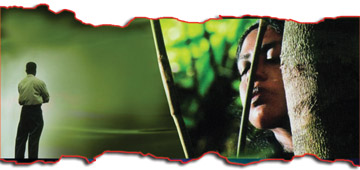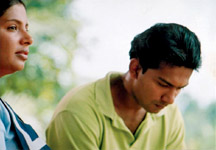|
observer |
|
|
|
|
|
OTHER LINKS |

|

|

|
|
Trailblazers of Fine Arts: I do not want to be a 'film maker' but want to make films..." - Satyajit Maitipe
Within his relatively short stay in the medium, Satyajit with his film, Bora Diya Pokuna's complex structure, an apt and sluggish diction outside the traditional structure that opens up new avenues for creativity, has, certainly, taken Sri Lankan filmgoers to the hitherto untrod-territories of life, psychosis, diverse mentalities and to the innermost recesses of human mind. Reflections
Reflecting on his childhood most of which he spent in Kurunegala with his parents, Satyajit believes that his father (Mr. Premasinghe Maitipe) who had been his 'best friend' of his from as young as four years, had a lifelong impact on moulding his perception of life and was largely responsible for his love-affair with the medium of cinema, as his father had also been a lover of films. "Actually I learnt the meaning of 'love' and 'dignity' from him and that was the best gift (apart from Buddhism) I can think of" he says. "He loved my mother so much. He was so humble and dignified to seek forgiveness from his 4 year old son, when he mistakenly punished me. I thank my Karma that he was my father", he reflects. As he grew up in age and stature, Satyajit's allure with the medium also grew and developed into a serious interest. He confesses that he does not like 'words', the words the country uses as they are incapable of 'capturing the moments of truth' and 'visual ' is much more stronger. This he cited as the major reason for his not engaging in the theatre which, according to Satyajit, depends a lot on dialogue. Satyajit is of the view that although he uses dialogues in cinema, he always tries to explain to actors that 'truth' is somewhere in between the words. Commenting on his education, Satyajit evokes how his mother (Mrs. Gertrude Maitipe) who was a Nursing Administrator wanted to make him a doctor which she thought was the greatest profession in the world. This led to a definite failure and thus effectively changed the future course of his life. (He fell hopelessly in love at the age of 16 and brought 4 F's home) For some time, Satyajit worked as a freelance journalist and contributed articles on cinema to the newspapers.
However, this life as a journalist had also been changed by a chance meeting of Satyajit with Somalatha Subasinghe and the late Richard de Zoyza ("I still call him my big brother") who encouraged Satyajit to sit for the Advanced level examination, once again, in the arts stream. They, in fact, selected his subjects. So Satyajit sat for the A/L in the arts stream and selected Sinhala, English, Political Science and Economics as subjects. Screen idolsAt the University, he read sociology, political science and English for his degree. It was also by coincidence that he met with the theatre personality Somalatha Subasinghe when she visited the Nursing School where Satyajit's mother was the Principal. Although Satyajit was not interested in joining Somalatha's acting class, this chance meeting established a strong artistic and intellectual bond between Satyajit and Somalatha. As most of the youngsters of the day, Satyajit also had his favourite film stars or screen idols; Douglas Ranasinghe with whom he later developed a kind of intellectual relationship and Swarna Mallawarachchi (whom he considers as one of Sri Lanka 's best actresses). Satyajit's entry into the field of cinema was marked by his maiden Tele Film "Smarana Samapti" (An absolution). The maiden work was conceived largely based on Satyajit's personal observations during the 1987-90 period and the tragic death of Richard de Zoysa and Richard's mother, Dr. Manorani Saravanamuttu's tragedy. Satyajit recalls nostalgically the agony and the pain that Manorani endured though she put up a brave face before many a public forum. "Manorani was such a generous and dignified human being and her pain and tragedy was totally unfathomable. It disturbed me deeply in a spiritual sense." Satyajit recalls. The work was acclaimed as one of the best contemporary productions, by supporters of diverse political parties and social backgrounds. Irrespective of political ideology, the eclectic audience was so moved that some of them were choked with emotion at the end of the screening. Satyajit considers this as the biggest achievement apart from the awards that he won for "Smarana Samapti". "When two people who are completely ideologically opposed feels emotional about the same thing it is a moment of profound truth, I feel," he says. It won the best Tele-film of the year 2000 in addition to the award conferred on Satyajit by the Sri Lanka Film Critics Forum who hailed the work as very cinematic even though the television camera used for the production. It was also this creation that convinced Satyajit that as major Sri Lankan filmmakers, he also has a specific area in the medium to be explored. According to Satyajit, in "Smarana Samapti", a story which is based on 87-90 tragedy, the three main roles were played by Chandani Seneviratne, Irangani Serasinghe and Peter de Almeida. Their representation of the characters was subtle and very subdued. The three of them were great actors and knew what subtle playing is all about. As characters, they were very dignified even though they were going through extremely complex emotions and were severely traumatized. However, in "Bora Diya Pokuna" (www.scentofthelotuspond.com) the main characters were overtly dramatic in dealing with life. They are grappling with life, chasing dreams and fighting for the pleasures of life perhaps in a raw, brutal manner. They are all hunters and victims at the same time. But their lives are unknown to themselves; who is the victim and who is being hunted. The metaphor murky water (Bora Diya) was used to suggest that environment in which the story evolves which is confusing and the protagonists are unaware of their plight, fighting as dogs against each other. Diverse viewsAccording to Satyajit, some senior film makers did not like "Bora Diya Pokuna" as it depicts uncouth characters; Mangala, Gothami and Vipula who are raw in their social behaviours, handling of conflicts and the way in which they face complex issues including love, relationships and sex. They were of the view that the story (Bora Diya Pokuna) was convoluted and over plotted. And they perceived Gothami's character as a tragic character like 'Joan of Arc' who at the end was destined to die or commit suicide. However, Satyajit believes that like some of the complex characters in Buddhist Theri Gee (Psalms of the nuns) who later attain Arahathship, Gothami's character did not deserve to commit suicide. From a Buddhist perspective, he believes that there always is a 'way out' however difficult the circumstances the character or characters. Like in Samsara, the story too has apparently no clear beginning, middle and a definite end. The essence of the plot; yearning for liberation and some situations of "Bora Diya Pokuna" are partly biographical. Some incidents also reflect some of the conflicts Satyajit and his friends and colleagues experienced, though set against a different social milleu. At first, the complex structure that evolved for the film was organic as well as subconscious. However, when friends and colleagues started questioning the cinematic structure he understood that it was in the format of a Jataka Story (Buddhist parable) and stuck to his format against the advice of distinguished film makers and his intellectually sophisticated friends. Though set against a complex social millieu and on the working class lives in the Free Trade Zone, the film's primary intention was not purely to reflect on these lives and their innumerable hardships in a purely logical socio-political analysis. Satyajit relied heavily on Buddhism in posing unanswered questions. Toward the end of the film, Mangala, Gothami and Vipula lead different lives and grapple dissimilar fates even though they come from the same social segment. Salient featuresOne of the salient features of "Bora Diya Pokuna" is that more focus was on human behaviour and to capture those subtle emotional expressions than on composing, lighting and other cinematic and technical aspects of film making. Satyajit believes that sexuality plays an organic and a natural role in life and the main characters of the film and some of their conflicts are also connected to their sexuality which is an integral part of their lives. If somebody is incapable of gaining happiness through sex, (unless it is a 'genuine spiritual quest') he sees it as a 'dreadful incompleteness' in the cycle of life. "I look at people who argue otherwise with a smirk. I genuinely feel 'sorry' for them." He retorts. In "Bora Diya Pokuna" Satyajit uses sex and sexuality as a metaphor and climatic ingredient as the characters are in constant conflict and go through a range of deep emotions. However, the complex structure and the seemingly incongruent incidents, especially the scene at the start of the film; a drama is rehearsed at a Dhamma school which has apparently no connection with the rest of the film and narrative pace, fast moving at the start and becomes slower as the story develops, are all in keeping with the emotions and life-rhythms of the characters. As an artist and film maker, Satyajit uses the medium of films as a cathartic expression and as a stage to carry on a dialogue with the audience. Bora Diya Pokuna is more or less a reflection of a spiritual Journey from a Buddhist perspective of life. According to Satyajit, Bora Diya Pokuna is not a blatant social - political comment but a personal spiritual comment on society, the established hypocrisy on sex, love and marriage. |
 Having evolved a radical structure and a diction which is unique to
himself, one time film lover, Satyajit Maitipe's entry into the field of
cinema has not only revolutionized the conventional perception of Sri
Lankan cinema which is more or less based on classical (European
/Western story telling structures and) traditions but has also given an
entirely different dimension to the conventional notion of structure of
the film with a beginning, sequential climax and end.
Having evolved a radical structure and a diction which is unique to
himself, one time film lover, Satyajit Maitipe's entry into the field of
cinema has not only revolutionized the conventional perception of Sri
Lankan cinema which is more or less based on classical (European
/Western story telling structures and) traditions but has also given an
entirely different dimension to the conventional notion of structure of
the film with a beginning, sequential climax and end. 









